Rail-mounted guns, or 'railway guns' and armoured trains have existed around the world almost since the steam locomotive became a viable machine. Many of these guns consisted of nothing more than standard artillery pieces, usually anti-aircraft, lashed to flat wagons or well wagons while armoured trains were generally armed with along the lines of Bren guns, a 6-pounder and Boys rifles. The Boys rifle was a rather ineffective 55in anti-tank weapon which was phased out as the Second World War progressed, but not before over 60,000 had been produced and placed into service with many Allied forces. Captured examples were also used by the Wehrmacht, who designated them ‘13.9mm Panzerabwehrbüchse 782(e)’. The 'Boys' name was taken from Captain H C Boys who led the design team.
Two armoured trains patrolled, for a time, the North Cornwall line to Padstow although not simultaneously. Said to have been based at Wadebridge from where they patrolled the Camel Estuary it is possible that they were also seen at Halwill and Bude but it must be stressed that no firm evidence has yet come to light. One of these trains is also known to have patrolled the Bodmin and St Austell areas.
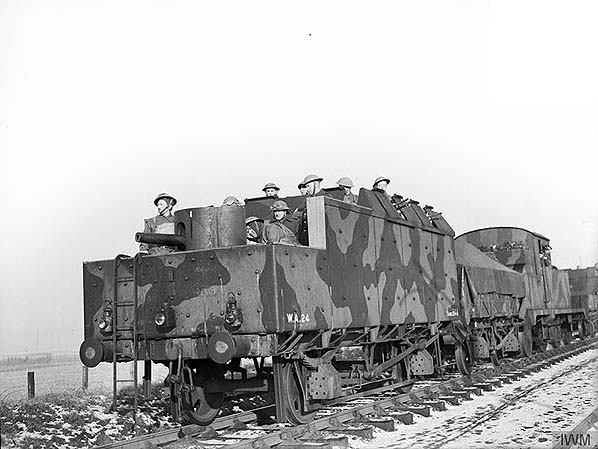
An armoured train, and possibly Armoured Train D which is known to have patrolled the North Cornwall line, seen here a long way from Cornwall at North Berwick on 4 February 1941. This train was armed with one 6-pounder (seen here), two Boys rifles and six Bren machine guns. These trains were initially manned by Home Guard and later by regular soldiers, in the case of this photograph, Polish. The wagons were adaptations of standard types and locomotives were ex GER 2-4-2T's. These trains were disbanded in 1943-44 when the threat of invasion receded.
Reproduced under IWM non commercial licence. © Imperial War Museum H7033
For War Department purposes eight sidings were installed at Halwill on land south of Dreybury Lane and on the Up side of the railway. Access was via a long loop with trap siding/headshunt at each end. The north end points were just south of Halwill level crossing and the south end points immediately before the Beaworthy Road bridge. From approximately halfway along the loop branched a spur, from points trailing in the Up direction, and from this spur fanned the sidings. It was at the south end of this loop that the 1944 mishap occurred when, owing to wrongly set points, a locomotive ran through the buffers on the trap siding and ended up in the road adjacent to the bridge.
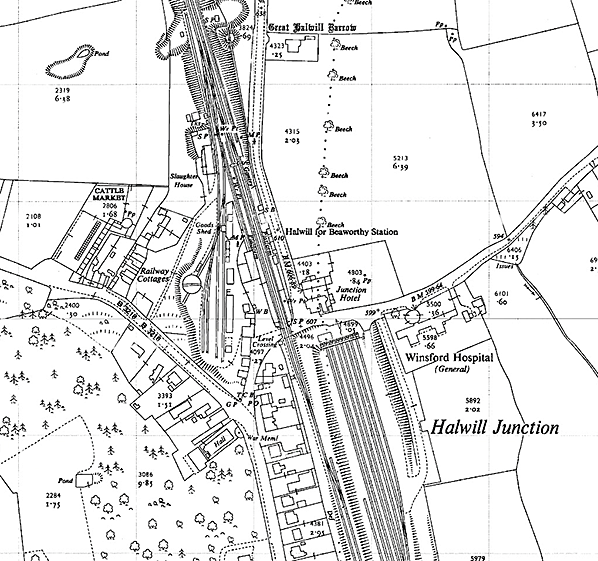
1954 1:2,500 OS map showing much of the military sidings to the south of Halwill station. Photographic evidence suggests that all sidings were originally the same length; if so, that at bottom left of the site had been shortened at some time. Today the site is occupied by a primary school and playing fields, and the fan area towards the bottom is overgrown but the general layout of still obvious from the air. The site extended south as far as the bridge over the Beaworthy Road, the abutments of which can still be seen.
The sidings were opened on 26 September 1943 as just one of the many preparations for the Normandy Landings of June 1944 and better known as D-Day, but it is possible that some sort of facility existed earlier due to extra wartime traffic in connection with troop training at the nearby firing ranges around Okehampton. These ranges date back to the nineteenth century and remain in use today. In the build-up to D-Day, troops and equipment were amassed at numerous locations and the sea crossings embarked from Suffolk and points right around the south coast, including Dartmouth and Falmouth, as well as from Cardiff and Swansea in South Wales. Further sidings were also installed at Tower Hill (no, not the station on the Circle and District Lines, but that between Halwill and Launceston) as indeed were many others during wartime across the country.
The loop was known as No.1 Siding (referring to loops as sidings was normal practice) and could contain 60 wagons plus locomotive. No.1 siding would be the limit for steam locomotives, with the sidings themselves being shunted by diesel locomotives, of which more anon. Diesels would have been used so as not to give away the position of the sidings to enemy aircraft at night and also because of the presence of munitions, which were supplied by the United States Army. The north end of the loop was controlled by a ringed signal (basically a type of shunt signal found at the commencement of goods yards and sidings and once common on the Southern Railway) which was No.30 signal. This signal was on an additional dolly added to Halwill Up Starting signal and it was for this reason that the previous signal post was replaced by a bracket type. The sidings, excluding the loop, had a capacity of 220 wagons with a 'wagon' being defined as a 10 ton 4-wheel van. The points at the south (Ashbury) end of the loop were controlled by ground frame C and, although unconfirmed, it would almost certainly have been unlocked by, or with, Annett's Key obtained from Halwill signal box. As already mentioned, it was the incorrect setting of these points which was the cause of the 1944 accident. A photograph from 1959 shows the loop, at least, to have still been in use but the ringed signal appears to have gone by that time so, presumably, post-war a ground frame was also installed at the loop's north end but at the time of writing this remains unconfirmed.

Railway guns of the type we are primarily concerned with here were monstrous purpose-built Howitzers. Once seen in many countries across the globe, the type familiar during WWII originated in WWI with, to single out a particular case, two British examples which saw action on the Western Front. These were HMG Boche Buster and HMG Scene Shifter (HMG - His Majesty's Gun). These Railway Howitzers, to quote their proper name, were built by the Elswick Ordnance Company, a division of Sir W G Armstrong Whitworth & Co Ltd, Newcastle upon Tyne. They were fitted with 14in calibre barrels which had been ordered by Japan for fitting to a twin turret on her battleship 'Yamashiro' but were never shipped out. A curious, to the layman, twist resulted from the intended use by Japan. Being designed for a twin turret gun the barrel fitted to HMG Scene Shifter had a left-hand loading breech while that fitted to HMG Boche Buster a right-hand breech. The latter was usual on British artillery. On these two WWI guns, the names were painted onto the barrel as, apparently, were various mottos from time to time. In Britain 14in was not a standard military calibre so following the end of WWI the barrels were removed and eventually scrapped in 1926. Their carriages, however, survived. In 1940 HMG Scene Shifter was given a new 13.5in barrel and HMG Boche Buster a new 18in barrel. However, there is some confusion about this and it is possible HMG Boche Buster was also given a 13.5in barrel, this only to be replaced later with an 18in barrel which itself had been developed in 1920. Five were constructed together with two sets of railway equipment. Bore was 52ft and weight of barrel and breech combined was 87½ tons. Traverse was a mere 2deg left and right and elevation 40deg maximum. Shells were some 6ft long with 2,500lb high explosive and fired by cordite. Effectively range was in the region of 12 - 13 miles. The whole ensemble weighed in the region of 250 tons and weight was spread over 16 axles, 32 wheels in total.
HMG Scene Shifter was joined by two more 13.5in guns; HMG's Gladiator and Piece Maker. The latter is often thought to be a spelling error when in fact it was a witty and deliberate play on 'Peace Maker', 'Piece' in this case referring to pieces of debris following a shell strike. This type of wit was quite common among the wartime military for obvious reasons - it was excellent for morale. These guns, along with other types, were deployed in Kent as was HMG Boche-Buster, the WWII incarnation of the latter being spelled with a hyphen and with the name proudly displayed on the proper nameplate cast, presumably, in brass or bronze. 'Boche-Buster', incidentally, is sometimes misspelled 'Bosch Buster' with or without the hyphen. A 'Bosch Buster' is somebody who breaks sparking plugs.
WWII HMG's Gladiator, Piece Maker and Scene Shifter were designed to be capable of shelling German positions in the Calais area from Kent but HMG Boche-Buster's range did not permit this. The purpose of this and other Railway Howitzers was to shell a seaborne invasion. The problem with these large Railway Howitzers was the negligible traverse, which meant they had to be positioned on lengths of track which allowed the barrel to point towards the sea or, had the enemy landed, to wherever the target happened to be. Where this was not possible special sidings were sometimes built in order to provide the required trajectory and often these were curved to compensate for the next-to-useless traverse of the guns. It should be remembered that on railway howitzers of this size, limited traverse was necessary as otherwise the weight of the barrel would destabilise the carriage and the reaction to the recoil when a shell was fired would probably cause it to topple.
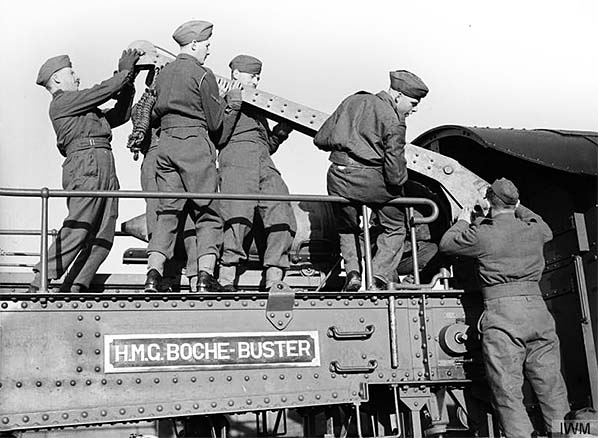
Before being deployed on the Elham Valley Line in Kent, HMG Boche-Buster could be found at Catterick where she was photographed a number of times. Here she is on 12 December 1940 during a training exercise. One of the 6ft-long shells can be seen on its trolley; the breech is out of view to the left. Shells were stowed in the covered vehicle on the right and placed on the trolley by means of the small crane and then transferred to the breech, this operation also being assisted by mechanical means. Of additional interest in this view is the nameplate, which is by no means a crude affair. One may question the need for such nameplates in wartime when materials were scarce but Winston Churchill strongly approved owing to the morale value both to service personnel and the public. The Germans were fully aware of the existence of these guns and, no doubt, also to their names so the names would also have had some propaganda value. The Germans named many of their similar weapons but the remit of the fascist state dictated that names commemorated people of supposed honour within the Reich and the touches of witty humour so typical of the British were generally lacking
Reproduced under IWM non commercial licence. © Imperial War Museum H6091
The story of HMG Boche-Buster on the Elham Valley Line is well known but the story can be recapped here. The gun was never to be fired in anger but a number of test, training and morale-boosting demonstration firings were made.
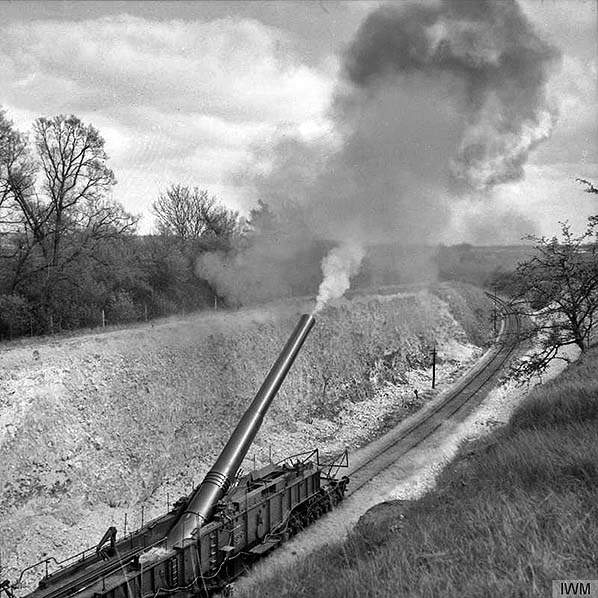
Here is HMG Boche-Buster after a firing on 7 May 1941, a few weeks prior to the famous visit by Winston Churchill to Bishopsbourne on the Elham Valley line. The barrel elevation has meant that the breech is not easily discernible but it has made it easy to see the saddle upon which the barrel normally rests. Precisely what has been fired is not known as artillery shells were not the only projectiles; experiments were also conducted with smokebombs, for example, but it is not known if HMG Boche-Buster was involved with such. Whatever had been fired in this view, such non-anger firings were not undertaken on a whim and the position would have been chosen to ensure that the projectile landed in the sea and with minimal risk to shipping and the public along the way. Note this is 'minimal' risk rather than 'no' risk.
Reproduced under IWM non commercial licence. © Imperial War Museum H9448
At this point it is worth looking at what was happening in Germany. Whilst Germany had what one might call 'conventional' railway guns and Howitzers, at the request of the German High Command (OKH - Oberkommando des Heeres) in the 1930s the well-known firm Krupp of Essen developed what was to be the largest such gun ever. With the first built at Krupp's expense, a tradition of the company, two more were ordered but only one of these was completed. Named 'Schwerer Gustav' and 'Dora', they required twin railway tracks, i.e. double track, weighed 1344 tonnes and required a crew of no fewer than 500 men (HMG Boche-Buster required a crew of twenty). High explosive shells of 10,654lb could be fired a distance of 23 miles with alternative concrete-piercing shells a distance of 29 miles. These guns had been intended to destroy the forts along the Maginot Line but they were brought into service too late and when Germany invaded France they simply and, it must be said, amusingly, went around the ends of the line. France quickly surrendered and destruction of the Maginot Line was rendered unnecessary. The guns, the first of which appeared in 1941, were thus redundant before they even entered service. The two completed guns did see some action elsewhere and, for example, were taken to Leningrad (although it was never used), Stalingrad, Warsaw and Sevastopol. For transport, which was by train, the guns had to be dismantled and upon arrival at the required sites special tracks had to be laid for them. The barrels had to be replaced after firing 300 rounds and the worn barrel sent back to Krupp for relining but this was a requirement for all such guns.
Whilst 'Schwerer Gustav' was built at Krupp's expense, the OKH was charged 7,000,000 Reichsmark for 'Dora' meaning effectively that OKH paid 3,500,000 Reichsmark for each gun. This money would have paid for a mountain of infantry weapons or a fleet of fighter aircraft although the politics behind this were by no means that simple and are not relevant here. The Maginot Line had been constructed during the 1930s and the implication that 'Schwerer Gustav' had been developed pre-war with its destruction in mind calls into question when precisely Hitler had decided to invade France but, again, the politics behind this are complex. These enormous guns were ultimately to prove just another example of the waste of men, money and resources which ultimately came to characterise an increasingly deluded Adolf Hitler. Both guns and the uncompleted third were destroyed at the end of the war. One of the 800mm shells can be seen at the Imperial War Museum, London, while another exists in Warsaw. Arguably HMG Boche-Buster was ultimately to prove a similar waste of men, money and resources but it should be remembered that during wartime events can overtake events unexpectedly and the majority of Railway Howitzers, be they with the Allies or the Axis, did see some active service.
The invasion of mainland Britain (it should not be forgotten that the Channel Islands were occupied) became increasingly unlikely by 1943. Even the military leaders of the Third Reich, that is the true military men and not paramilitary cranks such as Heinrich Himmler, began to realise that the situation for Germany was hopeless from 1943. Thus it was that with the possibility of invasion looking increasingly unlikely, Britain's railway guns began to be stood down. HMG Boche-Buster, largely due to being incapable of firing across the Channel, left the Elham Valley line in 1943 for Salisbury Plain where she was engaged in trials of concrete-piercing shells. Examinations of photographs taken after this time suggest she had been given a modified or re-sleeved barrel for these trials.
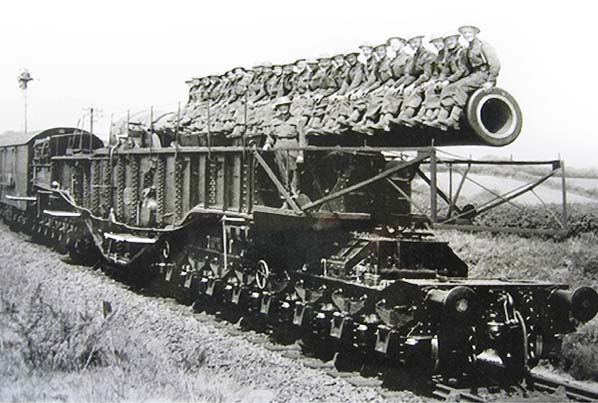
Here is HMG Boche-Buster posing with soldiers somewhere along the line between Halwill (to the left) and Ashbury. The date is 10 May 1944 and the occasion an exercise recorded by the Southern Railway Film Unit. Two diesel shunters, out of view in this scene, were present. One was an unidentified ex-LMS Armstrong Whitworth machine and the other was Southern Railway No.3 on loan to the War Department. No.3 went on to become BR No.15203. The demonstration obviously required co-ordination and this was achieved by radio. To this end a small hut was erected beside the line and close-by a radio mast was erected. It is possibly this mast which can be seen in the left background but what the device is on top of the mast is unclear; it might be nothing more than an unfortunately positioned flaw on the photograph. The firing occurred on the lengthy curve on the Halwill side of Ashbury to ensure that the gun was aimed towards the Dartmoor ranges. There is also vague evidence that single firing also occurred on the siding south of Ashbury goods yard which conveniently pointed to the military firing ranges, but details of this are not known if, indeed, it took place. Design of the Howitzer's carriage took recoil into account but even so it is said that the recoil was capable of pushing the entire machine several metres along the track. The film produced by the Southern Railway has survived and is now in the care of the Imperial War Museum. HMG Boche-Buster's nameplate is just visible on the far end of the carriage. Also visible is the builder's worksplate midway along the carriage. One of these plates has also survived in the Imperial War Museum collection but it is not known from which of the Railway Howitzers it came. The plate affixed to HMG Boche-Buster carried Armstrong Whitworth Works Number 17634 of 1918. The carriage, of course, dates from WWI. The surviving plate in the IWM collection carries no works number although the IWM believes it to have come from HMG Boche-Buster. Railway Howitzers may have carried more than one plate, for example on both carriage and barrel, but this is unconfirmed.
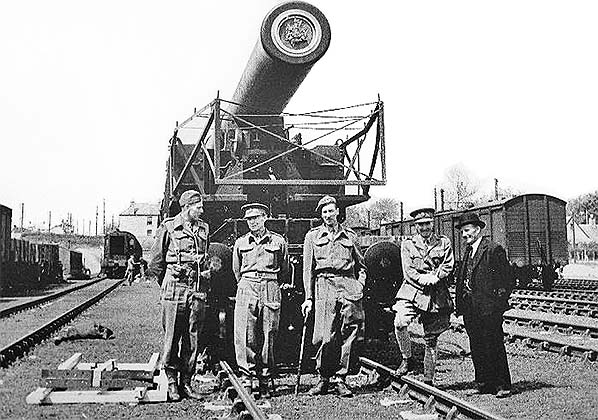
The only known photograph to date taken within the military sidings at Halwill. The date is believed to be 14 May 1944. A convenient reference point is the Junction Hotel, left background, while further left can just be discerned part of Halwill station. Posing in front of HMG Boche-Buster are army ratings and officers together with a civilian official, perhaps from the Southern Railway or the War Department. The Howitzer barrel has its seal in place on this occasion. The barrel here and in the previous view would appear to be a re-sleeved replacement, there being five such barrels available. Though it is not easy to count the number of sidings accurately there would appear to be eight. If so, that on the left was of the same length as the others thus proving this siding was shortened at some point (see 1954 map). Note the concrete sleeper blocks. Of particular interest here is the diesel shunting locomotive on the siding to the left. Following much manipulation of the photograph it can be determined as being one of the ex-LMS Armstrong Whitworth machines. The Army had a similar machine at Longmoor, acquired new, but that differed in detail and most notably in the rather strange angular design of its cab. To the left of the diesel is what appear to be rudimentary refuelling and maintenance facilities. There were at least two diesels at Halwill at this time, one known to have been SR No.3. It is worth noting that despite these shunters dating from the 1930s, a time when diesel rail traction was still in its infancy, these various types generally gave reliable service day in, day out. Experience had been gained from the use of diesel engines in marine applications, but whilst this experience may have suited the application of diesel power to shunting locomotives it was to prove a mistake when assuming the fundamentals of marine applications would suit the far more arduous conditions required of main line diesel locomotives. British Railways was to learn this lesson to its cost in the 1950s. One of the problems encountered in trying to identify individual locomotives at military locations, especially during wartime, is that the military moved them around frequently. That seen in this view was possibly former LMS No.7062 or 7063 but positive identification is impossible. More on these shunters is in the text.
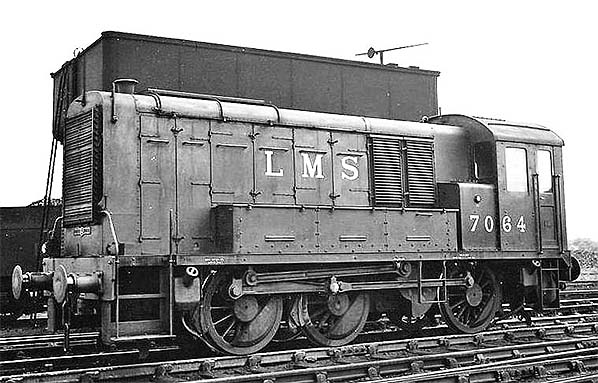
Armstrong Whitworth diesel-electric shunter LMS No.7064 at an unknown location sometime prior to WWII. These machines employed an Armstrong-Sulzer 6LTD22 engine married to Crompton Parkinson electrical equipment. Transmission was a single, enormous, traction motor mounted within the frames with jackshaft drive to the wheels. This arrangement was common at the time and also applied to the English Electric machines which went on to become BR Nos.12003 - 12032. Features to note are the 'fish belly' front coupling rod, small steam locomotive type exhaust chimney and Armstrong Whitworth plate below the radiator grille. Ten of these locomotives were supplied to the LMS in 1935/6 and numbered 7059 - 7068. In effect they were a follow-on from No.7408, later 7058, but differed in a number of ways. No.7064 was one of the class sent abroad during the war, 1944 in this case. She was to end up with SNCB (Belgian State Railway) and she survived until May 1961.
Photo from Jim Lake collection
The history of the Armstrong Whitworth shunters is complex. All ten were taken over by the War Department with all bar two, Nos. 7062/3, being sent abroad during the war. They carried various military numbers, War Department and MEF (Middle East Forces), while some which later operated for various state railways, including Egypt, carried numbers of their owning railways. A few of these shunters warrant an individual mention. Of the two which remained in Britain during the war, No.7062 eventually went to what was then West Germany in 1957 and she is known to have still been in service in 1975. No.7063 was destined never to leave Britain. She had an interesting career involving, along with others, being loaned back to the LMS before going back into military use only to be loaned back to the LMS again. When in military service she was numbered WD 883. She was overhauled by R Fenwick & Co, Brackley, sometime around 1958, whereafter she ended up at MoD Bicester at which location a well known photograph of her exists. She was then sold to E L Pitt, a dealer also in Brackley, during 1963 and was then sent in February 1966 for trials at CEGB Hams Hall. She travelled under her own power and, interestingly, the route was via Verney Junction and Bletchley. The section between Banbury Merton Street (exclusive) and Buckingham had been disused for almost three years and had become fairly overgrown in places*. It was reopened specially for the passage of the shunter and thus, apart from the track-lifting train, this was to be the final movement over this stretch of line. Her stay at Hams Hall was short-lived as she was scrapped on site during 1967, possibly after suffering a failure, but by that time shunters with the jackshaft drive arrangement were rapidly falling out of favour. Another example worth a mention is No.7060. She was one of several which had ended up in Egypt and was noted at 169 Railway Workshops, Suez, in 1945 withdrawn. A peculiar myth, which is still around today, then grew up around this locomotive along the lines of her supposedly being 'canalised' at Suez, in other words dumped in the Suez Canal. What actually happened was she was retained at the workshops to be cannibalised for spares for other class members which, incidentally, gave good service even in the conditions of Egypt. In 1951 she was again noted at the workshops but by now she had been heavily cannibalised to the point where little remained. The remains were finally scrapped in 1952. The myth about her being dumped in the Suez Canal probably arose from 'cannibalised' being distorted into 'canalised' together with incorrect assumptions about her being 'dumped' at Suez workshops. In any event, the remains of No.7060 were scrapped some years before the blockade of the Suez Canal during the Suez Crisis of 1956. None of the Armstrong Whitworth shunters ever returned to the LMS.
* There is some confusion over this. The line between Banbury and Buckingham had closed completely in December 1963. Banbury Merton Street remained open for goods traffic (mainly cattle) until June 1966 but after December 1963 was reached via the connection with the former GWR line through what was then Banbury General.
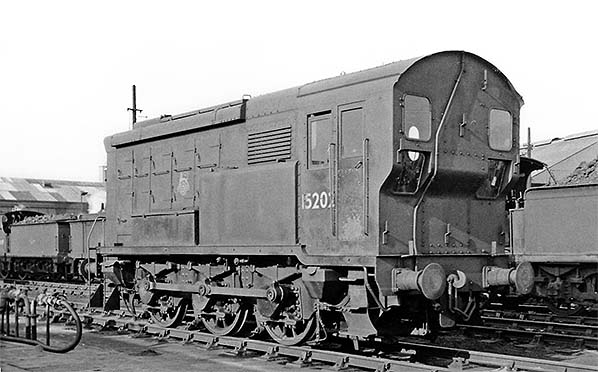
BR No.15202 at Hither Green. Formerly Southern Railway No.2 she was one of three identical machines which began life as SR Nos.1 - 3 in 1937. Built at Ashford, they used Hawthorn Leslie mechanical parts and English Electric equipment. They were of the twin motor type and thus similar, 'under the skin', to what became BR classes 08 - 12. Bodywork design was vastly different, though, most notably in the radiator, running plate and cab designs. The protruding extension to the rear of the cab and the slanted windows were to aid the driver when buffering-up and coupling. However, drivers were skilled at this task so in practice the feature was probably of little value other than, perhaps, when working on third-rail electrified lines. No.3 is the locomotive known to have worked at Halwill alongside an Armstrong Whitworth jackshaft example and was the locomotive present when HMG Boche-Buster was recorded by the Southern Railway Film Unit. Incidentally, as BR No.15203, No.3 disgraced itself by failing at Sheffield Park (now a station on the Bluebell Railway) in 1954. After being dumped at Sheffield Park for several days it was eventually towed to Brighton Works by a steam locomotive which happened to be on its way to Brighton with North British diesel No.10800 in tow, which had also become a failure. In War Department service, at least one of Nos. 1- 3 is known to have carried camouflage livery. This locomotive was involved in a collision with one of the Armstrong Whitworth examples on the Martin Mill Military Railway near Dover and ended up toppled onto its side. BR Nos.15201 - 3 survived until November 1964, December 1964 and November 1964 respectively. Ironically, given that Halwill was later to come under Western Region auspices, Nos.15202/3 had a short spell on that
Region during 1951/2.
Photo by Ben Brooksbank
Precisely when diesel shunters arrived at Halwill is not known but they would almost certainly have been the first examples of diesel rail traction to appear at the location. In any event, locomotives at military locations were changed frequently and especially during wartime. Whilst we know SR No.3 was at Halwill in May 1944 but the Armstrong Whitworth present at the same time remains unidentified other than the possibility, by power of elimination, that it was either LMS 7062 or 7063. SR No.3 is also known to have had a spell on the Elham Valley line together with at least one of the English Electric jackshaft locomotives; LMS No.7092 which went on to become British Railways No.12015 and was scrapped in 1968. There would have been at least one diesel at Halwill prior to the arrival of HMG Boche-Buster and it is likely that one or two more accompanied the Howitzer on its journey to Halwill. When the Howitzer was filmed along the line to Ashbury, two diesels were present including SR No.3. The implication, albeit vague, is therefore that during May 1944 at least three diesels were present at Halwill but at the time of writing only two have been confirmed; No.3 and an Armstrong Whitworth example.
HMG Boche-Buster, when being taken from Catterick to the Elham Valley line in Kent, was disguised to look from the air like a locomotive. The Germans knew of the existence of these guns but even if they did not they would have assumed Britain possessed such weapons; by May 1944 their existence would certainly have been known about. By this time, however, Nazi Germany was crumbling and aerial attack was moving into the phase of the V1 Flying Bombs and V2 Rockets. It can therefore be considered likely that the move of HMG Boche Buster to Halwill (from Salisbury Plain) was not done under any form of disguise although it would have been sheeted over and the journey probably undertaken at night. The gun was too heavy for Meldon Viaduct so the route was via Barnstaple Junction and Torrington. Motive power for this journey is unrecorded and although the diesels were probably present it is likely that they were towed but may have provided power for the Barnstaple - Halwill part of the journey. It must be stressed, however, that this is speculation and no confirmed details of the Howitzer's journey to Halwill have come to light.
Britain's railway howitzers had been scrapped by the 1960s. Following WWII the western world found itself plunged into the Cold War; the threat from this and any future wars were envisaged as being missile and atomic weapon wars in which there would be no place for the giant railway howitzers. This, however, was not the end of the HMG Boche-Buster story as one of her guns, No. L1, survived. It was last fired in 1959 at Shoeburyness to test 'Bunker Buster' bombs. No. L1 is one of only twelve Railway Howitzers remaining in the world. If this is confusing, No. L1 is the howitzer itself with the carriage being considered a separate component. Following the scrapping of the original carriage, No. L1 was transported on a proofing sleigh. This is a type of heavy railway bogie somewhat resembling of a tank. The next move was to Woolwich Arsenal where in 1991 it was gifted to the Royal Artillery Historical Trust. Here it was to remain until a move to Larkhill in 2008. In 2013 No. L1 was on the move again, this time to an exhibition in the Netherlands to mark the 300th anniversary of the Treaty of Utrecht which had brought to an end the Spanish War of Succession in 1713. The exhibition ran from March to September 2013. No. L1 is, as of July 2016, in store awaiting the opening of a new artillery museum planned for Larkhill.
Back at Halwill, when Winston Churchill was telling the nation, ‘We may allow ourselves a brief period of rejoicing’, the military sidings remained in use as ordnance and other equipment still required transport and disposal. When military use ceased is not known but it is known that in 1959 at least part of the sidings were still in use, by then probably by British Railways rather than the military. The site today is described with the 1954 map above. Apart from the overgrown sidings fan area, the site is unrecognisable as a former railway yard but the entrances adjacent to what is now the Junction Inn still give the feeling of a ghostly presence of long-gone military activity. Adjacent to the former bridge over the Beaworthy Road it is still possible to discern the site of the southern end of the loop which gave access to the sidings. It was at a slightly lower level than the main line which at that point had begun the climb towards Ashbury.
Sources:


 Home Page
Home Page 

 Home Page
Home Page